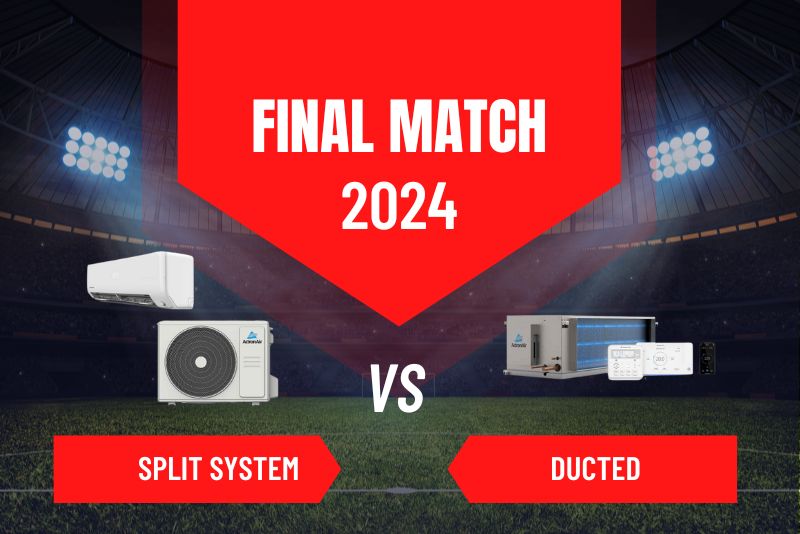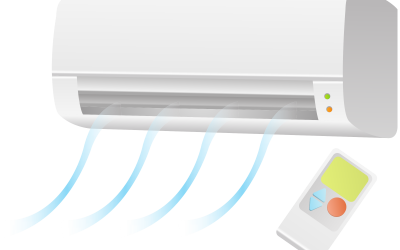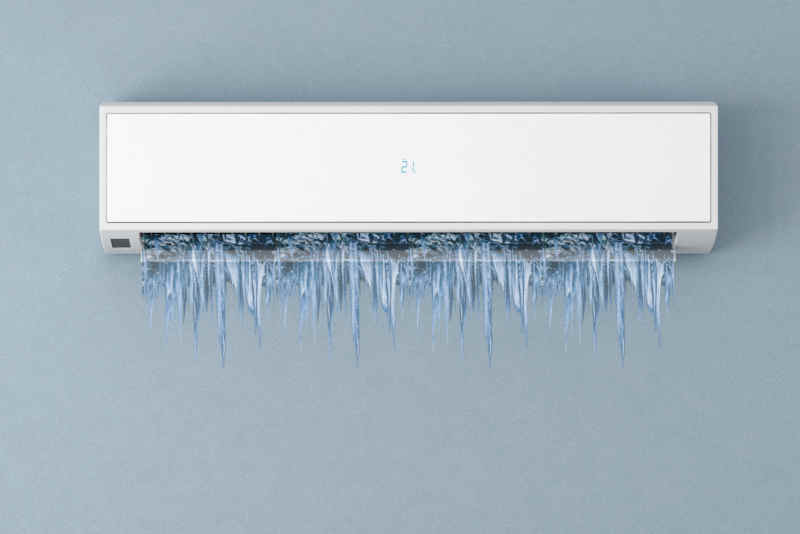When it comes to choosing the best air conditioning system for your home, the decision often comes down to either ducted air conditioning or split systems. Both have their own set of advantages and drawbacks, and the best choice largely depends on your home’s layout and your specific needs. In this updated guide for 2024, we’ll explore the pros and cons of each system to help you make an informed decision.
If you need personalised advice, feel free to contact us on 0403 254 272 for all your air conditioning needs in Brisbane.
Ducted Air Conditioning
Ducted air conditioners are centrally controlled systems designed to cool or heat an entire building through a network of ducts. These systems can be particularly advantageous for maintaining a consistent temperature throughout a home.
Benefits of Ducted Air Conditioning
- Whole-Home Cooling: A major benefit of ducted systems is their ability to cool the entire house using a single unit. The main unit cools the air, which is then distributed throughout the home via ducts, maintaining a consistent temperature in every room. This can also help preserve the condition of your home’s interiors, including flooring and furniture.
- Aesthetic and Quiet: Because the main unit is located out of sight, usually in the roof space, the only visible components are the discreet vents. This design makes ducted systems more visually appealing and quieter compared to split systems, which have visible and potentially noisy indoor units.
- Zoning Capability: Many ducted systems come with zoning options, allowing you to cool or heat different areas of your home individually. This feature can significantly improve energy efficiency and reduce running costs, as you can target only the areas in use rather than cooling the entire house.
- Set and Forget: With a central control unit, often wall-mounted, you can set your desired temperature for the entire house, and the system will maintain it automatically, providing a hassle-free experience.
Drawbacks of Ducted Air Conditioning
- Running Costs: Without zoning, ducted systems can be expensive to run as they cool the entire house even if only one room is in use. However, with proper zoning, these costs can be managed more effectively.
- High Upfront Costs: Ducted air conditioning systems are generally more expensive to purchase and install compared to split systems, as they require extensive ductwork and multiple vents throughout the home.
- Space Requirements: Ducted systems need significant space for ducts and the main unit, usually in the roof. Homes without sufficient roof space may not be suitable for ducted systems.
- Fixed Control: The control unit is typically fixed in one location, meaning you have to go to that spot to adjust settings. Some modern systems offer smartphone compatibility, providing more flexibility.
Split System Air Conditioning
Split system air conditioners consist of an indoor unit and an outdoor unit, designed to cool or heat individual rooms or areas. These systems are versatile and can be a good choice for cooling specific spaces within your home.
Benefits of Split System Air Conditioning
- Lower Upfront Cost: Split systems are generally cheaper to purchase and install compared to ducted systems. They require minimal installation, which also means a shorter setup time.
- Cost Spread: You can spread the cost of cooling your entire home by gradually adding more split systems over time, instead of a large upfront investment required for a ducted system.
- Suitable for Multi-Level Homes: Split systems can be installed in multi-level homes and apartments where ducting might not be feasible.
- Lower Running Costs: Since split systems only cool specific areas as needed rather than the entire house, their running costs can be lower than ducted systems, especially when used efficiently.
- Ease of Repair: Split systems are generally easier and cheaper to repair. If one unit fails, the rest of your home can still remain cool.
Drawbacks of Split System Air Conditioning
- Noise: The indoor units of split systems can produce noise, which may be disruptive. Additionally, the outdoor units can be noisy, potentially disturbing neighbours.
- Aesthetic Impact: Indoor units are mounted on walls, which can be visually obtrusive. The outdoor unit’s placement can also affect the exterior appearance of your home.
- Energy Usage: For larger homes, using multiple split systems can result in higher energy usage compared to a single ducted system, particularly if each unit is not used efficiently.
- Limited Cooling Power: Split systems are designed to cool specific areas. Larger spaces or homes with many rooms may require multiple units, potentially increasing both costs and energy consumption.
Ducted Systems are Cheaper When Compared To Having a Split System In Each Room
Ducted air conditioning systems are generally cheaper to run compared to having a split system in each room, particularly in the following scenarios:
- Large Spaces: In large homes or buildings with multiple rooms, ducted systems benefit from economies of scale, cooling or heating the entire space more efficiently than multiple split systems.
- Centralized Control and Zoning: Ducted systems with zoning capabilities allow for precise temperature control in different areas, reducing energy use by cooling or heating only the necessary spaces.
- Advanced Technology: Modern ducted systems often incorporate energy-efficient technologies like inverter technology, which can reduce running costs compared to multiple split systems.
- Installation and Maintenance: Installing and maintaining a single ducted system can be less expensive and less disruptive than managing multiple split systems.
Overall, ducted systems can provide more efficient and cost-effective climate control in larger or multi-room environments compared to having individual split systems in each room.
Split Systems Are Generally Cheaper To Run Than Ducted Systems When
Split system air conditioners are generally cheaper to run than ducted systems in the following scenarios:
- Small Spaces or Single Rooms: In smaller homes, apartments, or when only one or two rooms need cooling or heating, split systems are more efficient and cost-effective.
- Targeted Use: If you only need to cool or heat specific areas at different times, split systems allow for precise control, reducing energy consumption compared to cooling or heating the entire home with a ducted system.
- Lower Initial Costs: Split systems have lower installation costs compared to ducted systems, making them more economical for smaller installations.
- Less Complex Installation: Split systems require less invasive installation, which can be cheaper and quicker than installing a ducted system, especially in older homes not designed for ducted systems.
- Individual Control: Each split system can be controlled independently, allowing for personalized comfort and potentially lower energy use if only a few rooms are occupied at a time.
Overall, split systems are more cost-effective for smaller spaces, targeted use, and situations where lower initial and installation costs are important.
Choosing the Best Solution Based on Your Cooling Goals and Budget
Selecting the right air conditioning system depends not only on your home’s layout and size but also on your overall cooling goals and budget considerations. Here’s a deeper look into how these factors can influence your decision between ducted air conditioning and split systems:
Cooling Goals
Whole-Home Cooling:
If your goal is to maintain a consistent temperature throughout your entire home, a ducted air conditioning system might be the best choice. Ducted systems provide even cooling across all rooms and are ideal for larger homes or homes with open floor plans.
The zoning feature in ducted systems allows you to control the temperature in different areas of your home, providing flexibility and improved energy efficiency.
Room-Specific Cooling:
If you only need to cool specific rooms or areas, a split system is a more suitable and cost-effective option. Split systems are perfect for cooling bedrooms, living rooms, or home offices individually.
For multi-level homes or apartments, split systems offer the flexibility to install units where they are most needed without the extensive ductwork required by ducted systems.
Budget Considerations
Initial Costs:
Ducted Systems: The initial cost of purchasing and installing a ducted system is higher compared to split systems. This cost includes the main unit, extensive ductwork, and multiple vents. If you have a higher upfront budget and are looking for long-term whole-home cooling, investing in a ducted system can be worthwhile.
Split Systems: Split systems have a lower initial cost, making them an attractive option for those with a limited upfront budget. The cost includes the indoor and outdoor units, with minimal installation work required. You can start with one or two units and add more as needed, spreading out the expense over time.
Ongoing Costs:
Ducted Systems: Without zoning, ducted systems can have higher running costs as they cool the entire home, even if only one room is in use. However, with zoning, you can reduce these costs by cooling only the areas that are occupied. Regular maintenance of the ducts and central unit is also a consideration.
Split Systems: Split systems are generally cheaper to run since they cool specific areas. However, the running costs can add up if you have multiple units operating simultaneously. Maintenance costs are typically lower, as each unit operates independently, and repairs can be managed on a per-unit basis.
Other Areas You May Want to Consider When Choosing Between Ducted and Split Systems
When deciding between ducted air conditioning and split systems, considering the following additional factors can help you make the best choice for your home. Here’s an expanded look at why each point is important:
1. Energy Efficiency and Environmental Impact
Energy Ratings: High energy star ratings indicate greater efficiency, meaning lower energy consumption and reduced utility bills. This also translates to a smaller carbon footprint, making it a more environmentally friendly choice.
Green Technologies: Eco-friendly refrigerants and energy-saving features like inverter technology reduce greenhouse gas emissions and overall environmental impact. These technologies can also result in significant long-term savings on energy bills.
2. Installation Considerations
Structural Impact: Installation impacts, such as potential modifications to your home’s structure, can affect both the cost and feasibility of the system. Ducted systems require sufficient roof or underfloor space for ductwork, while split systems need suitable wall space for indoor units and appropriate locations for outdoor units.
Retrofit vs. New Construction: Retrofitting a ducted system into an existing home can be complex and costly, whereas split systems are easier to install in existing structures. In new constructions, both systems can be planned and integrated seamlessly, but the choice will still depend on the layout and intended use of the space.
3. Operational Control and User Experience
Smart Home Integration: The ability to integrate with smart home ecosystems allows for remote control, scheduling, and automation via smartphones or voice assistants. This convenience can lead to more efficient energy use and personalised comfort settings.
User Interface and Control Options: Easy-to-use control interfaces enhance user experience. Wall-mounted controls, remote controls, and app-based management options provide flexibility in managing your home’s climate.
4. Maintenance and Longevity
Maintenance Frequency: Regular maintenance, such as filter changes and unit servicing, is crucial for optimal performance and longevity. Knowing the maintenance requirements helps plan for upkeep costs and effort.
Durability and Lifespan: Understanding the expected lifespan and durability of each system helps in making a cost-effective decision. Ducted systems typically have a longer lifespan due to centralised components, but this also means that a failure can affect the entire system.
5. Noise Levels and Comfort
Indoor and Outdoor Noise: Noise levels produced by both indoor and outdoor units can impact home comfort and neighbourhood relations. Quieter systems enhance living conditions, especially in noise-sensitive areas.
Air Quality and Filtration: Efficient air filtration and humidity control improve indoor air quality, which is important for health and comfort, particularly for individuals with allergies or respiratory issues.
6. Cost-Benefit Analysis
Long-Term Savings: A thorough cost-benefit analysis, including long-term operational costs, energy savings, maintenance, and potential increases in property value, helps in understanding the total cost of ownership and financial benefits over time.
Financial Incentives: Exploring available rebates, tax incentives, or financing options can reduce the initial financial burden and make energy-efficient systems more affordable.
7. Climate and Regional Considerations
Local Climate Suitability: Different systems perform better under specific climate conditions. Considering local climate helps in selecting a system that operates efficiently and effectively in your region, ensuring optimal performance year-round.
8. Customer Reviews and Testimonials
User Experiences: Real-world insights from customer reviews and testimonials provide valuable information about the reliability, performance, and satisfaction levels of both systems, helping to inform your decision based on others’ experiences.
9. Health and Safety
Health Benefits: Improved air quality and humidity control can lead to better health outcomes, reducing allergy symptoms and respiratory issues. Understanding these benefits helps prioritise systems that contribute to a healthier living environment.
Safety Concerns: Proper handling of refrigerants and adherence to safety protocols during installation and maintenance are crucial to avoid hazards. Knowing the safety aspects ensures peace of mind and prevents potential risks.
10. Future Trends and Innovations
Technological Advances: Staying informed about emerging trends and innovations, such as solar-powered units, advanced sensor technologies, and AI-driven energy management systems, can help you choose a system that is future-proof and incorporates the latest efficiency and convenience features.
Market Trends: Understanding consumer preferences and the growing demand for smart, energy-efficient systems helps in making a choice that aligns with market trends, ensuring that your investment remains relevant and valuable.
Making the Decision
Ultimately, the decision between ducted and split system air conditioning depends on your specific needs or cooling goals, budget, and home layout. If you value whole-home comfort and aesthetics, a ducted system might be the best choice. If you’re looking for a cost-effective solution to cool specific areas, a split system could be more suitable.
For Comprehensive, Whole-Home Cooling: Ducted air conditioning with zoning is likely the best option, especially if you have a higher initial budget and prioritise consistent, even cooling throughout your home.
For Targeted, Room-Specific Cooling: Split systems offer flexibility and lower initial costs, making them ideal for those who need to cool specific areas or have a limited budget. They are also suitable for multi-level homes and apartments.
If you need personalised advice tailored to your specific needs and budget, contact Advanced Climate Solutions on 0403 254 272. Our experienced team is available to help you choose the best air conditioning system for your home.
FAQs on Ducted Air Conditioning vs Split System
Q. Which system is more energy-efficient: ducted or split system?
A. The energy efficiency of each system depends on the design, usage, and setup. Ducted systems with zoning can be more energy-efficient for whole-home cooling as they allow you to cool specific areas only when needed. Split systems are generally more efficient for cooling single rooms or small areas, as they will use less energy when only cooling smaller spaces in comparison to whole home cooling.
Q. Are ducted air conditioners more expensive to run than split systems?
A. Ducted systems can be more expensive to run if they cool the entire house without zoning. However, with zoning, you can reduce running costs by cooling only the areas in use. Split systems typically have lower running costs as they cool individual rooms, but using multiple units in a large home can increase overall costs.
Q. What is zoning in ducted air conditioning?
A. Zoning allows you to divide your home into different areas or zones, each with its own temperature control. This means you can cool or heat specific zones as needed, which can improve energy efficiency and reduce running costs.
Q. How much does it cost to install a ducted air conditioning system?
A. The cost of installing a ducted air conditioning system varies depending on the size of your home, the complexity of the installation, and the specific model chosen. Generally, it is more expensive than installing a split system due to the need for extensive ductwork and vents.
Q. Can I install a ducted air conditioner in an apartment or multi-level home?
A. Ducted systems are typically not suitable for apartments or multi-level homes due to the space required for ducts and the main unit. Split systems or multi-split systems are usually better options for these types of residences.
Q. What are the maintenance requirements for ducted vs split system air conditioners?
A. Both systems require regular maintenance to ensure optimal performance and longevity. Ducted systems may need periodic duct cleaning and checking of the central unit, while split systems require cleaning of the indoor and outdoor units. Regular filter cleaning or replacement is essential for both types.
Q. Are split systems noisy?
A. Split systems can produce noise, especially from the indoor unit. However, advancements in technology have reduced noise levels in modern units. The outdoor unit can also be noisy, which might be an issue if placed near living areas or neighbours.
Q. Can I control my air conditioning system with a smartphone?
A. Yes, many modern ducted and split system air conditioners come with smart capabilities, allowing you to control the system using a smartphone app. This can provide greater flexibility and convenience, especially for ducted systems with fixed control panels.
Q. Which system is better for large homes?
A. For large homes, ducted systems are often more suitable as they can efficiently cool the entire house using a single unit with zoning capabilities. Split systems can be used, but you may need multiple units, which can increase costs and complexity.
Q. How long does it take to install each type of system?
A. The installation time for split systems is generally shorter, often completed in a day, as they require minimal work. Ducted systems take longer to install due to the need for ductwork and multiple vents, which can take several days to complete.
If you have any more specific questions or need further assistance, feel free to contact Advanced Climate Solutions on 0403 254 272. Our team is ready to help with all your air conditioning needs.




